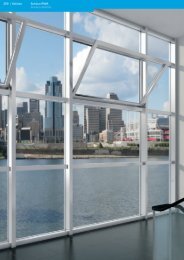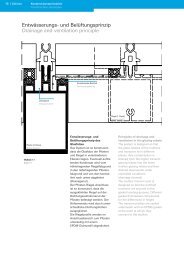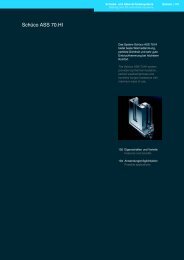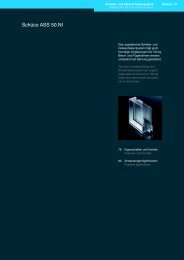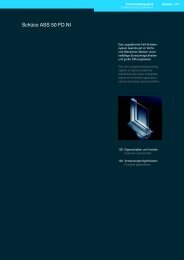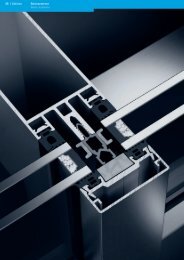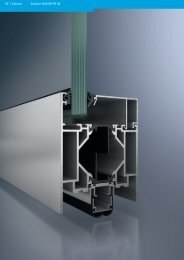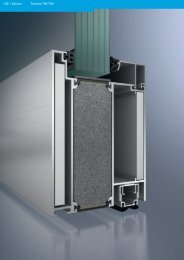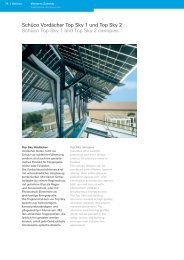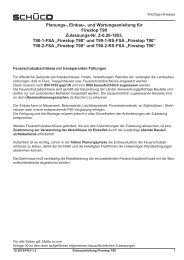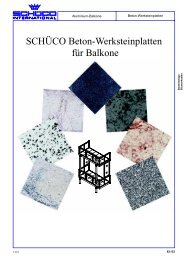PDF öffnen
PDF öffnen
PDF öffnen
Sie wollen auch ein ePaper? Erhöhen Sie die Reichweite Ihrer Titel.
YUMPU macht aus Druck-PDFs automatisch weboptimierte ePaper, die Google liebt.
Verklebung der Structural Glazing-Isolierglasscheiben und der Structural<br />
Glazing-Paneele mit UV-beständigem Randverbund bzw. Verklebefuge mittels<br />
Zweikomponenten-Silikonkleber z. B. DOW CORNING® 993 oder Sikasil® SG-500<br />
auf eloxierten Aluminiumprofilen. Die Verarbeitungsvorschriften des<br />
Klebstofflieferanten DOW CORNING bzw. Sika Services AG sind unbedingt zu<br />
beachten. Die Oberflächenbeschaffenheit der Aluminiumprofile muss den<br />
Vorgaben von Schüco und des Klebstofflieferanten entsprechen.<br />
Die äußere Scheibe muss aus Einscheiben-Sicherheitsglas oder Verbundsicherheitsglas<br />
mit gehärteten Einzelscheiben bestehen.<br />
Die äußere Scheibe muss, mindestens zur Hälfte ihrer Dicke, durch den<br />
Glasträger gestützt werden.<br />
Beim Einsatz der Trockendichtung muss die Fuge (Nennmaß 20 mm) zwischen<br />
18 mm und 23 mm breit sein.<br />
Zum Ausfüllen der Wetterfuge eignen sich neben den Schüco Silikontrockendichtungen<br />
die Silikone DOW CORNING® 791, DOW CORNING® 756sms,<br />
DOW CORNING® 797 und DOW CORNING® 795 der Firma DOW CORNING<br />
sowie Sikasil® WS-305 und Sikasil® WS-605 S der Firma Sika Services AG.<br />
Scheibenüberstand aus optischen Gründen mit Silikon abspachteln, bedrucken<br />
etc.<br />
Weitere Hinweise<br />
Die mögliche Einbauhöhe von Structural Glazing-Fassaden unterliegt in der Regel<br />
nationalen und/oder lokalen Bestimmungen bzw. ist von weiteren Bedingungen, z. B.<br />
vom Einsatz einer zusätzlichen mechanischen Sicherung der Glasscheiben,<br />
abhängig.<br />
Es können nationale und/oder lokale Bestimmungen die Vorgaben und Anmerkungen<br />
der ETAG 002 bzw. ETA einschränken bzw. präzisieren. Nationale und lokale<br />
Bestimmungen sind ebenfalls zu berücksichtigen, falls die für die Baugenehmigung<br />
zuständige Stelle dies vorschreibt.<br />
In Ländern der Europäischen Union sind die Vorgaben der Europäischen Technischen<br />
Richtlinie (ETAG 002) für Structural Glazing-Fassaden und die in der Europäischen<br />
Technischen Zulassung (ETA) Nr. 05/0114 gemachten Angaben zwingend<br />
einzuhalten.<br />
Schüco empfiehlt diese auch dann einzuhalten, wenn das Bauvorhaben sich<br />
außerhalb der Europäischen Union befindet. Alle Abweichungen sind vorher Schüco<br />
anzuzeigen und von Schüco und/oder dem Klebstofflieferanten zu genehmigen.<br />
Glas und Klebstoff (Silikon)<br />
Es dürfen bei Isoliergläsern für eine so genannte Structural Glazing-Fassade nur<br />
Randverbundverklebungen verwendet werden, welche gegen UV-Strahlung<br />
widerstandsfähig sind. Die erforderliche Glasdicke und die Scheibenrandausbildung<br />
sind mit dem Glaslieferanten abzustimmen. Alle Kombinationen von Glas,<br />
Glasbeschichtung und Kleber sind unter den jeweiligen Herstellern abzustimmen<br />
(Gewährleistung). Die Verklebe-Eigenschaften zwischen der Oberflächenbeschichtung<br />
des Glases und dem Klebstoff (Silikon) sind vom Glashersteller nachzuweisen.<br />
Bei transparentem Glas ist eine Bemusterung vor Produktionsbeginn durchzuführen.<br />
Profile und Klebstoff (Silikon)<br />
Die mit dem Glas zu verklebenden Profile müssen die in der Europäischen<br />
Technischen Zulassung (ETA) beschriebenen Oberflächeneigenschaften aufweisen.<br />
Ersatzweise können durch objektbezogene Tests des Silikonlieferanten ausreichende<br />
Oberflächeneigenschaften auch bei Oberflächen nachgewiesen werden, die nicht<br />
nach ETA festgelegt sind. Für die rechtzeitige Vorlage aller erforderlichen<br />
Genehmigungen ist alleine der Verarbeiter der Profile verantwortlich.<br />
Konstruktionsprinzipien<br />
Construction principles<br />
Bonding of Structural Glazing double-glazed panes and of structural glazing<br />
panels with UV-resistant edge seals or bonded joints using two-component<br />
silicone adhesives e.g. Dow Corning® 993 or Sikasil® SG-500 on anodised<br />
aluminium profiles. The fabrication instructions from the adhesive<br />
manufacturers Dow Corning and Sika Services AG must be strictly adhered to.<br />
The surface properties of the aluminium profiles must correspond to Schüco<br />
specifications and those of the adhesive supplier.<br />
The outer pane must be toughened safety glass or laminated safety glass with<br />
individual panes of tempered glass.<br />
The outer pane must be supported over a minimum of half its thickness by the<br />
glazing support.<br />
When the dry gasket is used, the seal (nominal size 20 mm) must be between<br />
18 mm and 23 mm wide.<br />
Besides the Schüco silicone dry gasket, the weather gaps can be filled using<br />
silicones DOW CORNING® 791, DOW CORNING® 756sms, DOW CORNING® 797<br />
and DOW CORNING® 795 manufactured by Dow Corning and Sikasil® WS-305<br />
and Sikasil® WS-605 S manufactured by Sika Services AG.<br />
For reasons of appearance, apply silicone to the glass overlap and smooth it<br />
off.<br />
Further information<br />
The permissible installation height of structural glazing façades is generally subject<br />
to national and/or local regulations, or is dependent on other additional conditions<br />
such as the use of additional mechanical means of securing the glass.<br />
National and or local regulations may restrict the specifications and remarks of the<br />
ETAG 002 and ETA or make them more precise. National and local specifications<br />
must also be taken into account if prescribed by the body responsible for issuing<br />
building approvals.<br />
In the countries of the European Union the regulations of the European Technical<br />
Guidelines (ETAG 002) for structural glazing façades and the details given in the<br />
European Technical Approval (ETA) No. 05/0114 must be strictly adhered to.<br />
Schüco also recommends adherence to these even if the building project is located<br />
outside of the European Union. Any deviations from this must be declared to Schüco<br />
in advance, and approved by Schüco and/or the adhesive supplier.<br />
Glass and adhesive (silicone)<br />
All edge bonding used for insulating glass in a so-called structural glazing façade<br />
must be resistant to UV radiation. The required glass thickness and the pane edge<br />
specification must be agreed with the glazing supplier. All combinations of glass,<br />
glass coating and adhesive must be agreed with the relevant manufacturers<br />
(guarantee). The adhesive properties between the surface finish coating of the glass<br />
and the adhesive (silicone) must be tested by the glazing supplier. If transparent<br />
glass is used, a sample must be taken before production starts.<br />
Profiles and adhesive (silicone)<br />
The profiles, which are to be bonded to the glass, must show the surface finish<br />
properties described in the European Technical Approval (ETA). As an alternative,<br />
adequate surface properties on surfaces not laid down in the ETA can be proved by<br />
project-related tests carried out by the silicone supplier. The fabricator of the profiles<br />
is entirely responsible for presenting all the required approvals in good time.<br />
Schüco | 43<br />
FW 60 + SG<br />
FW 50 + SG



